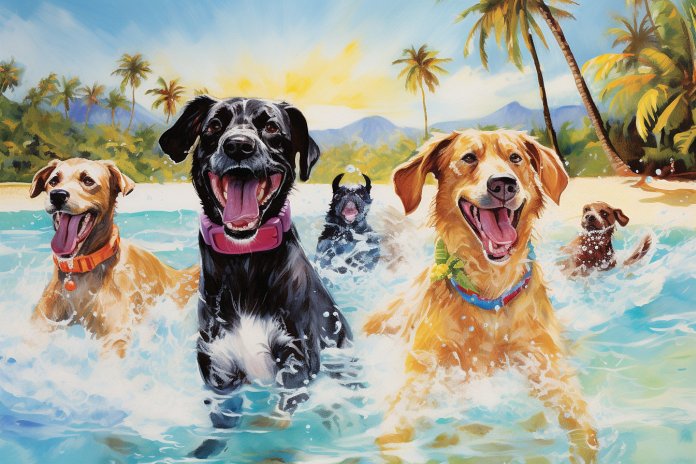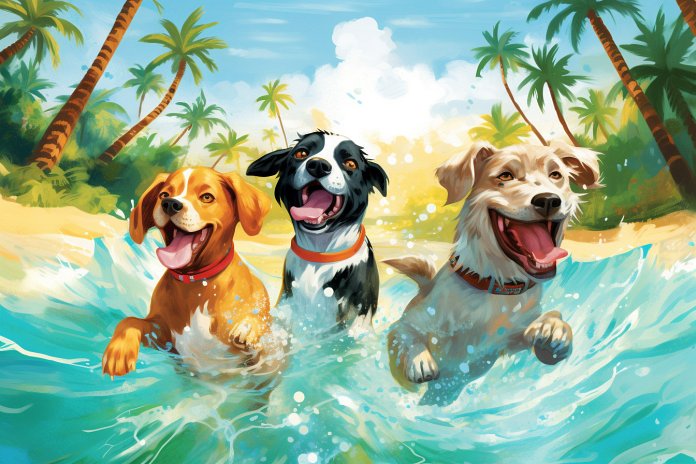
Summer’s here and it’s getting hot outside. As a responsible dog owner, you may be wondering how well your furry friend can handle the heat. Different breeds have different abilities to cope with hot weather, so it’s important to take care of your dog when temperatures rise.
Signs Your Dog Isn’t Coping with the Heat
Dogs aren’t as good as humans at staying cool. They don’t sweat like we do, so they rely on panting to regulate their body temperature. However, if their body temperature rises faster than they can cool down, they can suffer from heat stroke, which can be fatal if not treated.
Look out for these signs of an overheating dog:
- Rapid, heavy panting
- Elevated body temperature
- Signs of distress
- Dark red or purple tongue
- Increased drooling
- Reluctance to move
- Weakness
- Vomiting
- Stumbling and dizziness
- Collapse
- Coma
Brachycephalic breeds (dogs with short snouts) and dogs developed for cold climates are more susceptible to heatstroke. If you notice any signs of heatstroke, it’s important to cool your dog down immediately and seek veterinary attention.
Body Language
Pay attention to your dog’s body language for signs of heat stress, such as panting, weakness, lack of focus, sweaty paws, and dropped ears. Other signs to watch for include dizziness, increased body temperature, decreased urination, and rapid heart rate.
The Science of Dogs in Hot Weather
Dogs rely on panting and breathing rapidly to cool themselves down, but this isn’t a very efficient method. If your dog is showing signs of heat stress, it’s crucial to quickly reduce their body temperature to prevent damage to their organs. However, use cool water instead of icy-cold water to avoid causing the skin to feel excessively cold.
Because dogs aren’t great at regulating their body temperature, it’s important to avoid pushing them too hard during exercise in hot weather and never leave them in a hot car.
Caring for Your Dog in Hot Weather
To prevent your dog from overheating, avoid exercising them in the middle of the day when temperatures are highest. Provide access to clean, fresh water in multiple bowls and be cautious of metal bowls heating up in the sun. Create shade and provide good ventilation for your dog, but they’ll be even better off if they can escape the heat indoors with you.
There are additional measures you can take to keep your pet comfortable, such as using a cooling pet bed, setting up a kiddie pool with water, or making frozen treats. By planning ahead and taking steps to keep your dog cool, they can enjoy the summer weather safely.
“Keep your furry friend cool and comfortable in the summer heat.”

Tips & Things to Know
1️⃣ Recognize the signs of heatstroke in your dog: Look out for rapid panting, elevated body temperature, distress, dark red or purple tongue, increased drooling, reluctance to move, weakness, vomiting, stumbling, collapse, coma, and other signs of overheating. Brachycephalic breeds and dogs developed in cold climates are particularly prone to heatstroke.
2️⃣ Cool your dog down immediately if you notice signs of heatstroke: Bathe them in cool water and sit them in a cool area with a fan. Provide fresh water to drink and seek veterinary attention as soon as possible.
3️⃣ Take precautions to prevent overheating: Pay attention to your dog’s body language for signs of struggling with heat, such as panting, weakness, lack of focus, sweaty paws, and dropped ears. Avoid exercising your dog in the middle of the day and provide access to shade, ventilation, and ample fresh water. Consider additional measures like a cooling pet bed, a kiddie paddling pool with water, or frozen treats to help keep your dog comfortable in hot weather.
Frequently Asked Questions, Answered ✅
1. What are some signs that my dog is overheating?
– Rapid, heavy panting that continues even while your pet is resting
– Elevated body temperature (101.5° is a normal temperature)
– Signs of distress
– Dark red or purple tongue
– Increased drooling
2. Which breeds are more prone to heatstroke?
Brachycephalic breeds, such as Bulldogs and Pugs, are particularly prone to heatstroke, while dogs developed in cold climates, like the Siberian Husky, also tend to have a harder time coping with the heat.
3. What should I do if I suspect my dog is experiencing heatstroke?
If you notice any signs of heatstroke, it’s critical to cool your dog down immediately. Bathe them in cool (not icy-cold) water and sit them in a cool area in front of a fan. Provide plenty of fresh water to drink and seek veterinary attention as soon as possible.
4. How do dogs regulate their body temperature in hot weather?
Dogs are unable to sweat through their skin like humans. Instead, they rely on panting to lower their body temperature. However, this method isn’t very efficient, making heatstroke a real threat in warmer weather.
5. How can I care for my dog in hot weather?
To ensure your dog doesn’t suffer from overheating, avoid exercising them in the middle of the day and provide access to clean, fresh water at all times. Create shade and ventilation, and consider investing in a cooling pet bed or providing a kiddie paddling pool with water.